Rachel Carson Remembered
Air Date: Week of May 25, 2007

Rachel Carson (Courtesy of U.S. FWS)
Living on Earth commemorates the life and legacy of Rachel Carson, the science writer who inspired the modern environmental movement in America. Carson would have turned 100 years old this week. Her landmark book "Silent Spring," in which she warned of the dangers of DDT and other synthetic pesticides, is widely considered one of the most important books of the 20th century. Living on Earth's Bruce Gellerman visited the Cape Cod Museum of Natural History as curators were preparing the nation's largest exhibit celebrating Carson's centennial.
Transcript
CURWOOD: From the Jennifer and Ted Stanley Studios in Somerville, Massachusetts - this is Living on Earth. I’m Steve Curwood.
Silent Spring. With those two words Rachel Carson sparked the modern environmental movement back in 1962. Her book captured the public’s imagination with its devastating account of the dangers of pesticides such as DDT. When Silent Spring was published Rachel Carson was already the winner of the national book award for her best-selling volume, the Sea Around Us. And let me read from her acceptance speech:
“Many people have commented with surprise on the fact that a work of science should have a large popular sale. But this notion that "science" is something apart from everyday life, is one that I should like to challenge. The materials of science are the materials of life itself. Science is part of the reality of living; it is the what, the how, and the why of everything in our experience. It is impossible to understand man without understanding his environment”.
Rachel Carson was born 100 years ago this month, on May 27, 1907 and her birthday is being commemorated in many places. Living on Earth’s Bruce Gellerman traveled to Cape Cod for this appreciation of the legacy of Rachel Carson.
GELLERMAN: In the auditorium at the Cape Cod Museum of Natural History, in Brewster Massachusetts a short video recounts the life of Rachel Carson.
VIDEO: She started by writing radio scripts about fish. She continued as a junior aquatic biologist. In 1936 one of only two professional women in her agency.
GELLERMAN: This video was produced by the US Fish and Wildlife Service where Carson worked as a writer for 16 years.
VIDEO: Her science meticulous, her writing still regarded as some of the best…
GELLERMAN: Her friends said that “Ray” Carson, as they called her, was a born writer. She was just 11 when her first story was published and she wrote her first two books both on the science of the oceans while she was still working for the Fish & Wildlife Service.
DWYER: Rachel’s writing is very interesting in that it’s not pure science and it’s not pure literature. It’s well-written science.
GELLERMAN: Bob Dwyer is the Executive Director of the Cape Cod museum. He says Carson’s 1952 book “The Sea Around Us” made the bestseller list for more than a year and won the National Book Award. Carson took complex science and made it accessible to the layperson. But she’s most famous for the book she published a decade later, “Silent Spring.” It was a pioneering piece of investigative journalism fact based and hard hitting. The book detailed the disastrous, ecological consequences of synthetic pesticides.
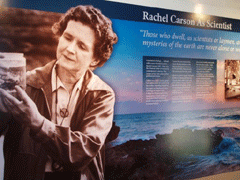
"Awakening Nature's Voice: Rachel Carson 1907-2007" will be on exhibit at the Cape Cod Museum of Natural History through November 30, 2007. (Courtesy of Bruce Gellerman)
VIDEO: Her 1962 book “Silent Spring” challenged American agriculture and caused society to re-think it’s relationship to the natural world, she was far ahead of her time, her work changed the world forever
GELLERMAN: Time Magazine later named Rachel Carson one of the most influential people of the 20th Century and yet, says Bob Dwyer, when the Museum began to work on the Carson centennial exhibit curators were surprised by what they found.
DWYER: What we thought is that people would remember who Rachel Carson was and we were basically going to have a modest exhibit. And what we learned as we started to put this together is that folks just did not remember who Rachel Carson was. And we realized that we had an incredible opportunity to tell a story, bring somebody back to life that is really the head of the environmental movement as we know it.
GELLERMAN: The Carson exhibit on Cape Cod is a collaboration with the U.S. Fish and Wildlife Service.
KLINGER: We have so much stuff that even a lot of it is not gonna be able to go on display because we don’t have the room.
GELLERMAN: David Klinger is a senior writer with the service. In the basement of the museum, Klinger rummages through boxes of Carson’s files and photos. There’s a replica of the brass diving helmet Carson wore while doing research at the Marine Biological Laboratory in nearby Woods Hole.
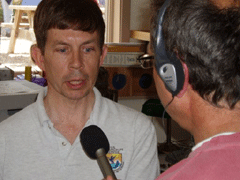
David Klinger, Senior Writer at the USFWS (Courtesy of Bruce Gellerman)
Klinger finds a piece of paper. It’s a Fish and Wildlife press release from 1946 which Carson - as Editorial Director of the Service - helped write:
[PRESS RELEASE READING]
GELLERMAN: Government press releases like this one contained the seeds that would later grow into the book Silent Spring. But these early warnings fell mostly on deaf ears.
[Paul J. Smith (composer) “Leave It To Beaver (Theme)” from ‘All Time Top 100 TV Themes’ (TVT – 2005)]
GELLERMAN: Post World War Two America was a place of unbridled faith in science and technology. Nuclear power promised electricity too cheap to meter. It was an era of “better living through chemistry,” and Dave Klinger says synthetic pesticides like DDT played a big part.
KLINGER: You’re not only looking at a chemical compound but you’re looking at an attitude in the 50’s and 60’s that said chemicals are all good for you but there weren’t as many warnings being sounded about the downside of these things.
[RUMMAGING THOUGH A BASEMENT]
GELLERMAN: Klinger reaches behind a box and finds evidence of what he’s talking about, an old hand-pump spray can that was once filled with insecticide.
KLINGER: Take a look at these pesticide containers. Virtually all of them have five to 15 percent DDT in them, which is really what she wrote about in “Silent Spring.” This is the kind of stuff that was commonly sold in drug stores and grocery stores.
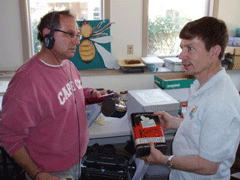
David Klinger holds a can of "Keyspray" insecticide spray. (Courtesy of Bruce Gellerman)
KLINGER: Well they certainly encourage you. It says it’s an extremely effective, pleasantly scented insect spray. But I mean, it was almost comical some of these brand names and how the only good insect was a dead insect.
GELLERMAN: Synthetic pesticides, like DDT were created as weapons during World War II. But Rachel Carson knew they could also be weapons against nature. DDT, Carson said in “Silent Spring,” was not an insecticide but a Biocide.
CARSON: We spray our elms and the following springs are silent of robin songs. Not because we sprayed the robins directly but because the poison traveled step by step through the now familiar elm leaf, earthworm robin cycle.
GELLERMAN: Carson said DDT and other synthetic pesticides were also killing beneficial insects, like honeybees, wreaking havoc on birds of prey, like bald eagles, and working their way up the food chain poisoning people, and disrupting our endocrine systems. “Silent Spring” hit like a bombshell. The chemical industry vilified Carson. She was called an irresponsible woman. The largest manufacturer of DDT said she wrote, quote: “Not as a scientist but rather as a fanatic defender of the cult of the balance of nature.” Every effort was made to discredit her.
[RUMMAGING SOUNDS]
GELLERMAN: David Klinger searches for another box and pulls out a document pages sandwiched between plastic sheets. We came across her FBI file. It’s a two-page letter. That ah…
GELLERMAN: You can’t read it, it’s all been redacted it’s all blacked out. Yes, Dec. 11.
KLINGER: It looks like 11th or 14th 1962.
GELLERMAN: It says US Department of Justice Federal Bureau of Investigation. The New York office of the Immigration and Naturalization Service advised on August 30, 1962 that…and the rest of the page is
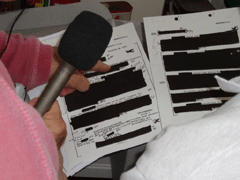
Rachel Carson's FBI file. (Courtesy of Bruce Gellerman)
GELLERMAN: That’s it. There’s nothing else of substance in the FBI document. But at the height of the cold war a link to Russia was enough to discredit anyone.
[MUSIC: Bob Dylan “The Times They Are A Changin’” from ‘The Times They Are A Changin’’ (Sony Music – 1964)]
GELLERMAN: In 1962, the civil rights movement was gathering steam. The anti-Vietnam war movement still lay ahead. Rachel Carson and the fledgling environmental movement, which “Silent Spring” helped spearhead, were at the front lines of dramatic social change in the US.
Bob Dwyer of the Cape Cod museum:
DWYER: I think what Rachel was trying to explain to people is that just because the government is trying to tell you something is ok doesn’t mean it’s ok. Ah, if you have some reason to question something, it’s your duty to do exactly that.
KLINGER: Rachel Carson was, she was a lone woman
GELLERMAN: Again David Klinger.
KLINGER: A lonely voice in the late 50’s and early 60’s getting into some pretty heavy weight subjects that really challenged government and agriculture and industry.
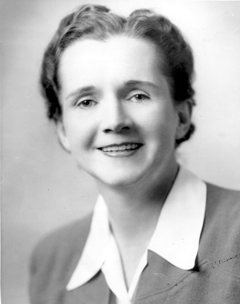
Rachel Carson (Courtesy of U.S. FWS)
GELLERMAN: After “Silent Spring” was published, President Kennedy convened a special commission to investigate pesticides. Klinger pulls out a picture of the panel.
KLINGER: And you notice of course that every member of the committee is a white male except for one woman at the tail end of the table, and that’s Rachel Carson.
GELLERMAN: Carson testified before the committee, which ultimately issued a report warning against the indiscriminate use of pesticides. She also appeared before the Senate, calling for the creation of a federal pesticide agency. By the end of the decade, Congress created the Environmental Protection Agency, which was given jurisdiction over pesticides. In 1972, the sale of DDT was largely banned in the US. And now, 35 years later, bald eagles may finally be taken off the endangered species list.
Still, in the decades since Carson wrote “Silent Spring,” the amount of synthetic pesticides used in the nation has doubled and they’re still part of everyday life. You can even find them here in the basement of the Museum of Natural History, where Rachel Carson’s archives are temporarily stored
KLINGER: Right over there is a can of OFF!
GELLERMAN: And that’s part, in your office, and that’s not part of the exhibit.
KLINGER: No, no, we still use chemicals. I mean, there is a place for chemicals.
GELLERMAN: Rachel Carson agreed if she was misunderstood by the chemical industry, well she was sometimes misrepresented by the fledgling environmental movement as well.
CARSON: Anyone who has really read the book knows that I do not advocate the complete abandonment of chemical control, that I criticize modern chemical control, not because it controls harmful insects but because it controls them badly and inefficiently; and because it creates many dangerous side effects in doing so. I criticize the present methods because they are based on a rather low level of scientific thinking. We really are capable of much greater sophistication in our solution to this problem.
GELLERMAN: Less than two years after Rachel Carson gave this speech at the National Women’s Press Club she died of breast cancer, which she battled quietly while writing “Silent Spring.” The book has never gone out of print.
GELLERMAN: David Klinger, from Fish and Wildlife.
KLINGER: You know, the power of this woman is in her words and what she wrote was not is not in a dusty old book from 50 years ago, it’s as contemporary as today.
GELLERMAN: Rachel Carson: environmentalist, scientist and journalist, would have been 100 years old this week.
The Rachel Carson exhibit at the Cape Cod Museum of Natural History in Brewster, Massachusetts, is on display through November.
For Living on Earth, this is Bruce Gellerman.
[MUSIC: Bob Dylan “The Times They Are A Changin’ (Refrain)” from ‘The Times They Are A Changin’’ (Sony Music – 1964)]
CURWOOD: You can find a link to the Rachel Carson exhibit as well as a set of readings from her book “The Sea Around Us” on our website, l-o-e dot O-R-G.
Links
Living on Earth wants to hear from you!
Living on Earth
62 Calef Highway, Suite 212
Lee, NH 03861
Telephone: 617-287-4121
E-mail: comments@loe.org
Newsletter [Click here]
Donate to Living on Earth!
Living on Earth is an independent media program and relies entirely on contributions from listeners and institutions supporting public service. Please donate now to preserve an independent environmental voice.
NewsletterLiving on Earth offers a weekly delivery of the show's rundown to your mailbox. Sign up for our newsletter today!
 Sailors For The Sea: Be the change you want to sea.
Sailors For The Sea: Be the change you want to sea.
 The Grantham Foundation for the Protection of the Environment: Committed to protecting and improving the health of the global environment.
The Grantham Foundation for the Protection of the Environment: Committed to protecting and improving the health of the global environment.
 Contribute to Living on Earth and receive, as our gift to you, an archival print of one of Mark Seth Lender's extraordinary wildlife photographs. Follow the link to see Mark's current collection of photographs.
Contribute to Living on Earth and receive, as our gift to you, an archival print of one of Mark Seth Lender's extraordinary wildlife photographs. Follow the link to see Mark's current collection of photographs.
 Buy a signed copy of Mark Seth Lender's book Smeagull the Seagull & support Living on Earth
Buy a signed copy of Mark Seth Lender's book Smeagull the Seagull & support Living on Earth

